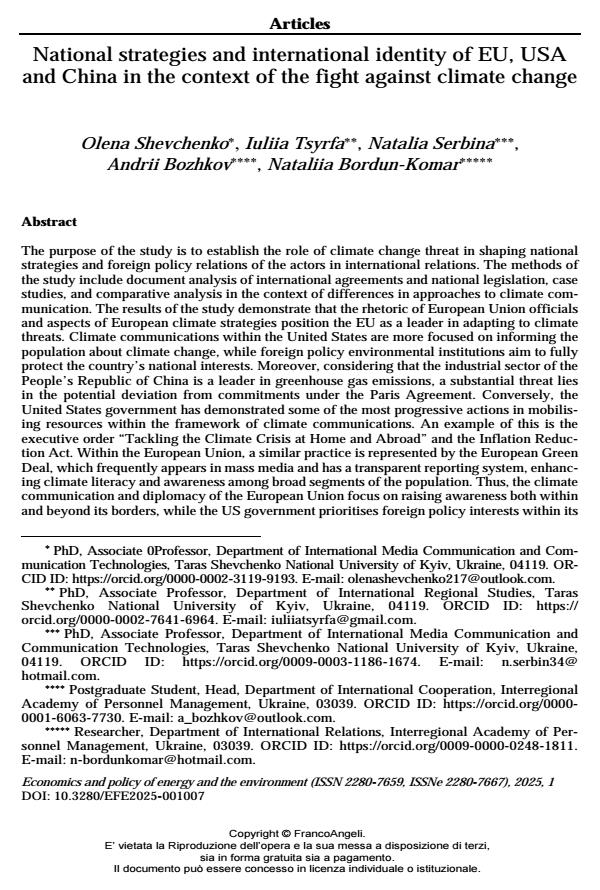National strategies and international identity of EU, USA and China in the context of the fight against climate change
Journal title ECONOMICS AND POLICY OF ENERGY AND THE ENVIRONMENT
Author/s Olena Shevchenko, Iuliia Tsyrfa, Natalia Serbina, Andrii Bozhkov, Nataliia Bordun-Komar
Publishing Year 2025 Issue 2025/1
Language English Pages 21 P. 169-189 File size 153 KB
DOI 10.3280/EFE2025-001007
DOI is like a bar code for intellectual property: to have more infomation
click here
Below, you can see the article first page
If you want to buy this article in PDF format, you can do it, following the instructions to buy download credits

FrancoAngeli is member of Publishers International Linking Association, Inc (PILA), a not-for-profit association which run the CrossRef service enabling links to and from online scholarly content.
The purpose of the study is to establish the role of climate change threat in shaping national strategies and foreign policy relations of the actors in international relations. The methods of the study include document analysis of international agreements and national legislation, case studies, and comparative analysis in the context of differences in approaches to climate communication. The results of the study demonstrate that the rhetoric of European Union officials and aspects of European climate strategies position the EU as a leader in adapting to climate threats. Climate communications within the United States are more focused on informing the population about climate change, while foreign policy environmental institutions aim to fully protect the country’s national interests. Moreover, considering that the industrial sector of the People’s Republic of China is a leader in greenhouse gas emissions, a substantial threat lies in the potential deviation from commitments under the Paris Agreement. Conversely, the United States government has demonstrated some of the most progressive actions in mobilising resources within the framework of climate communications. An example of this is the executive order “Tackling the Climate Crisis at Home and Abroad” and the Inflation Reduction Act. Within the European Union, a similar practice is represented by the European Green Deal, which frequently appears in mass media and has a transparent reporting system, enhancing climate literacy and awareness among broad segments of the population. Thus, the climate communication and diplomacy of the European Union focus on raising awareness both within and beyond its borders, while the US government prioritises foreign policy interests within its climate strategies. In contrast, the rhetoric of the government of the People’s Republic of China highlights the challenges in achieving the targets set by the Paris Agreement within the timeframe leading up to 2030.
Keywords: global climate change, climate communications, foreign policy identity, foreign policy, European Green Deal, climate diplomacy.
Jel codes: Q54, Q58, O44
Olena Shevchenko, Iuliia Tsyrfa, Natalia Serbina, Andrii Bozhkov, Nataliia Bordun-Komar, National strategies and international identity of EU, USA and China in the context of the fight against climate change in "ECONOMICS AND POLICY OF ENERGY AND THE ENVIRONMENT" 1/2025, pp 169-189, DOI: 10.3280/EFE2025-001007